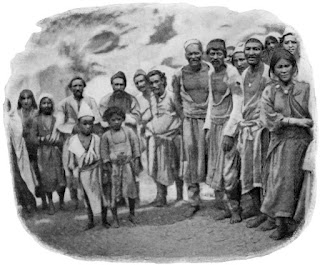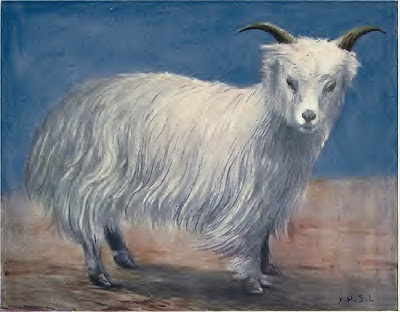 |
| Darma people (1897 ) |
The year 1962 is a watershed year in the history of Darma valley. The border with Tibet was closed off after the unfortunate war with China. With that came a momentous change in the economy and culture. It affected many aspects of life in these valleys. But what was it like doing business with Huniyas ( Tibetans) before all this happened? What was the life style like for a typical Darma trader? Here is an account by Makhan Jha and the paintings are by Henry Savage-Landour who visited Darma valley in 1897.
 |
| Goats carrying Borax |
The winter
settlements of the Darma Bhotia are the localities like Tejam, Sobla, Nyu, Dharchula, Balwakot, Galanti and
Kalika.Leaving the families in these villages. the traders set out
for their operations. First. they go to the trade fairs held at
Jauljibi. Thal and Bageshwar. in successive time order. where substantial
bulkof imported goods. particularly wool, woollen products.,
horse, pony. etc. are sold. As these fairs are over. the traders laden
the carrier animals for the phase of trading in sub-mountain
market centres_en route the local hill villages. The Darmi traders
reach their traditional foothills mandi at Tanakpur via
Pithoragarh and Lohaghat. The villages which lie surrounding this route are fre-quented by these traders where. principally. Salt, cereal,
barter would take place. Borax was also bartered with cereals of
the Kumaoni villages. But for wool and woollen products the
Bhotia normally liked cash though from traditional customers they
used to accept kind also. that is. grains realizing huge profit
margins by artful bargainings. From Tanakpur mandi they used to
procure jaggery. unrefined and refined sugar, cloth, leather products,
tea and fancy items and the richer traders even used to go to
Bareily or Kanpur for selling Tibetan goods and acquiring the aforesaid Indian items.
 |
| Darma valley - A view from above |
Except for very brief periods during summer and winter seasons the traders remained on the move. Only the strong-limbed.
able-bodied. courageous fellows of the family belonged to this
class.some of whom even would go to the distant mart Gartok (Tibet).or thrice in a year to the Tibetan and foot hlll marts as
against twice by the average traders.
 |
| A trade caravan on a high pass... |
Traders of Darma valley had a few intermediate stations for stockpiling the export goods. A systematic pattern was
evolved for conveniently carrying the merchandise from the sub-montane Indian marts to the Tibetan centres and vice versa. A few intermediate stations were famous tor dumping the goods.
These were Sobla (located at lower Darma. 5 km downhill of last
Bhotia village Dar which is non-migratory). and the high altitude
villages closer to Tibetan boundary. The export goods acquired from Tanakpur and the hill villages. were initially dumped at
Sobla by 2-3 trips within winter. when all the goods had thus been
stocik piled.preparations were done to shift those to the high altitude
(for example. Duktu. Go. Bidng, Dantu) dumping spots closer to
border where from the goods could be transported to Tibetan marts
within short time. By mid~July when the passes opened the
transportation of goods from Sobla to the high altitude was completed by
3-5 trips. This commenced since May end and the activity picked
up by mid—June with gradual receding of snow. Though the
distances are shorter than the pretty long route of Tanakpur-Sobla.
still the rough terrain and strenuous trekking would compel to
undertake more trips as the carrier animals had to be laden lighter.
Alter the Hariyala festival. final departure for Tibet would us-ually occur and the first batch of traders used to cross the
borderline by 15 July. The average Darmi traders usually did trade at
Silti Chhungra (smaller mart) in adjacent Tibetan region while the
bigger traders also visited Gyanima (Tibet). it took at least nine days
to reach Silti Chhungra from the southem most Bhotia village
Dar in Darma valley. A trader of Dar would make night halts at the camping grounds (parao) in successive order. Sela,. Nagling,. Duktu. Bidang. Pingru,
Dawe the last being at the bottom of Nuwe pass. The conditions beyond Go village used to become quite ditlicult. The firewood had to be carried alter Bidang parao
as vegetation would disappear completely after this camp.
 |
| A glacier on the way to the Darma pass |
The most tiring march would start alter Dawe. as to reach
the next parao. Mangwal (the first Tibetan camp site for the Darni
traders).the pass Nuwe had to be crossed by a steep ascending of
about six miles. At points. the route was so badly narrow and
risky that the sheep and goat had to be unladened first. then crossed
and then the traders carried the loads themselves. to be
reloaded on the carrier animals. Bigger transport animals like jabu,. Pony,
horse were utilized up to Dawe parao and the terrains of the pass prevented their further march. Besides. to avoid the strong
cold winds fatigue from the steep ascent. the Bhotia initiated
journey at daybreak (around 3 am) as they used to be anxious to
overcome the above hazards. On reaching the Mangwal parao (Tibet) alter 12 days long trekking. they would halt for the night and the
following noon they would reach their traditional chhungra (mart) of
Silti where the Tibetan traders also used to assemble…
From “The
Himalayas: An Anthropological perspective”
By Makhan Jha
 |
| Tibetan Goat |
Now it is all history. The times have changed. The present is very different. The trade and the associated life style is all part of the cultural memory. The old traders are almost gone.Very few remember the stories of the past. In this page I brought together whatever the text and images I could find about this chapter of the Darma valley history.
------------